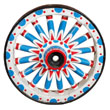The Norris and Rowe Angels Bandwagon
By Joseph Bradbury
(1) This wagon, which is one of my favorites, was heavily built, with splendid carvings featuring winged angles, musical instruments, and corner statues. The wagon was built in the winter of 1909-10 by the Leonhardt Wagon Works of Baltimore, Md., for the Norris and Rowe Circus. The carvings were done by Spanjers. This wagon was one of a set of four built and delivered to Norris & Rowe by Leonhardt in the early spring of 1910.
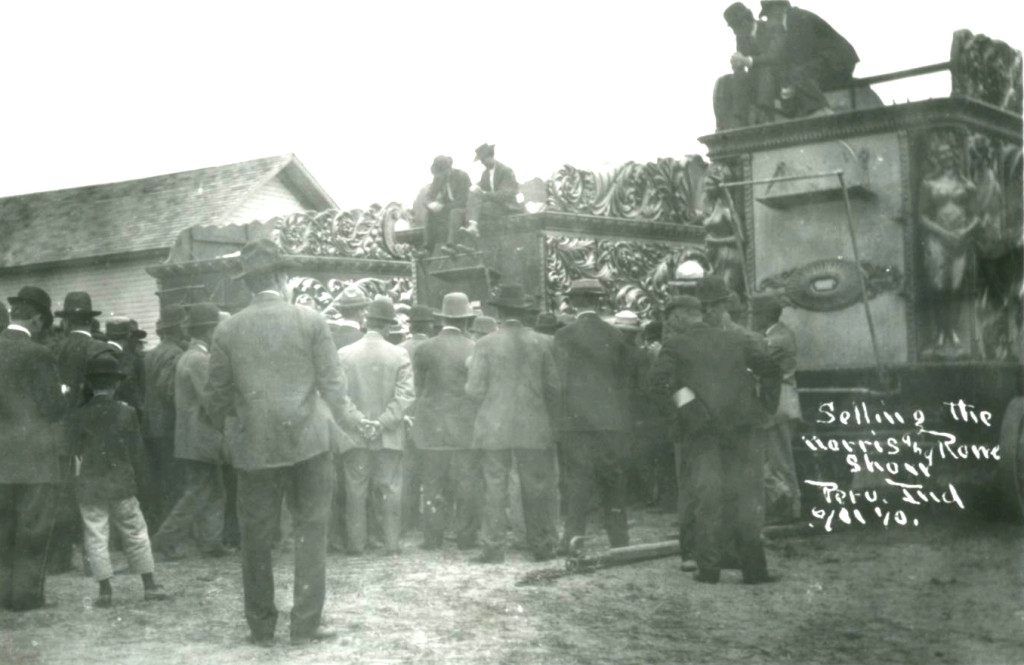 ( 1910- Conover Set # 914, photo # G133 – George Graf photo )
( 1910- Conover Set # 914, photo # G133 – George Graf photo )
Unfortunately the Norris & Rowe show was in financial difficulty and didn’t last but a few weeks after opening the 1910 season. The entire property was sent to Peru, Ind. for sale. The first sale which took place in June 1910 was thrown out by the courts, and a later sale was held in August of that year. Most of the property was purchased by Ben Wallace and William P. Hall. Hall got this particular wagon along with some others of the same set and shipped them to his farm at Lancaster, Mo.
In 1911 and 1912 the wagon was stored at the Hall Farm, and in the early spring of 1913 was sold to the Miller Bros. and Arlington’s 101 Ranch Wild West Show.
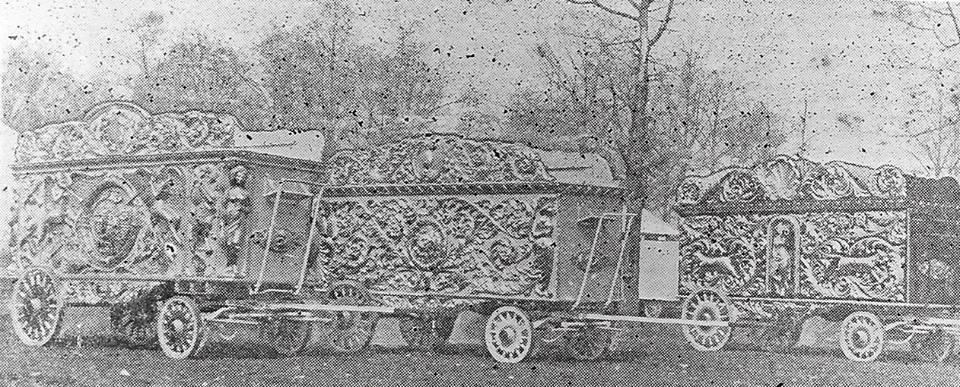 ( 1913 – Miller and Arlington’s 101 Ranch Wild West Show – Bandwagon, March/April, 1972, page 11 )
( 1913 – Miller and Arlington’s 101 Ranch Wild West Show – Bandwagon, March/April, 1972, page 11 )
For the seasons 1913, 1914, 1915, and 1916 the wagon was on the 101 Ranch Wild West Show. In 1917 the 101 property became known as the Jess Willard-Buffalo Bill Wild West Show and toured the 1917 season. Show was owned by Edward Arlington and Jess Willard. After the season closed the show property was stored for several months in Jacksonville, Fla. In 1918 all the Willard show property, including this wagon, was purchased by the Horne Zoological Arena Co. and sent to their place in Kansas City, Mo. I feel sure the wagon sat out the 1918 season in storage. Then it was sold to Fred Buchanan and placed on his Yankee Robinson Circus for the 1919 and 1920 seasons. I am not positive that the wagon was actually on the Yank show other than the 1920 season, but feel reasonably sure it was there also in 1919.
The Yankee Robinson Circus was purchased by Jerry Mugivan and Bert Bowers in the fall of 1920 and upon conclusion of the season the property was sent to the Hall Farm in Lancaster, Mo. Mugivan and Bowers also sent their 15 car Howes Great London Circus that had toured the 1920 season to the Hall Farm to winter. From the best equipment of the two shows a very fine 25 car show called the Howes Great London Circus was framed for the 1921 season. This wagon went along as the No. 1 bandwagon.
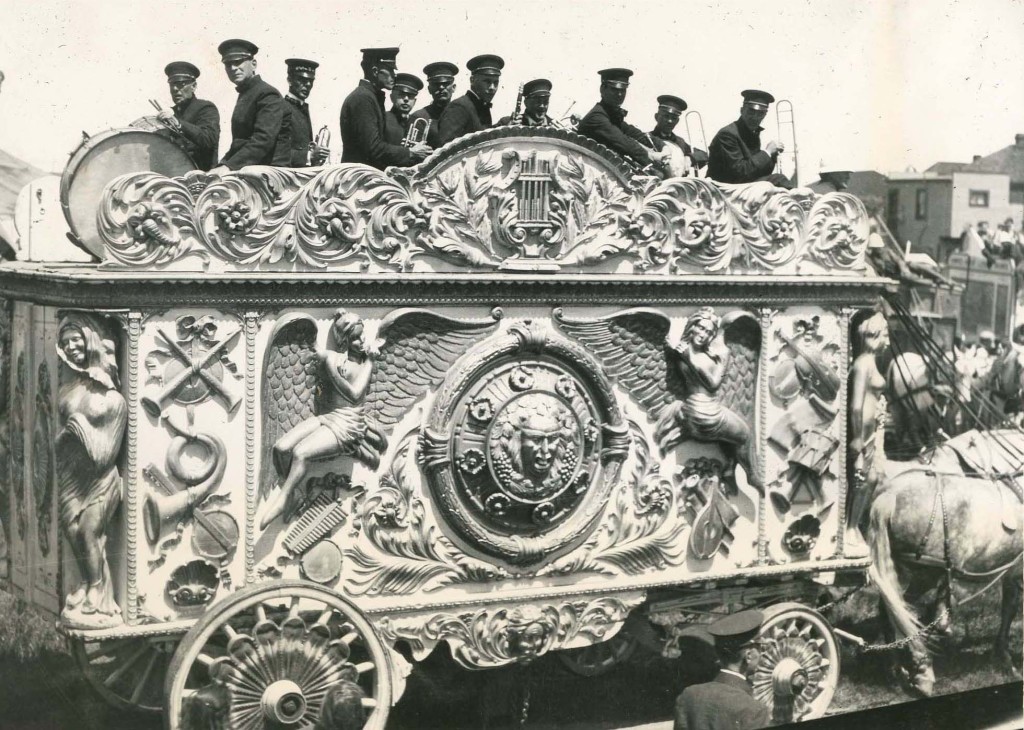 ( 1921 – Joseph Bradbury Album # 18 – photo # 99A – Howe’s Great London Shows – No.1 Bandwagon )
( 1921 – Joseph Bradbury Album # 18 – photo # 99A – Howe’s Great London Shows – No.1 Bandwagon )
In 1922 the Howe shows title was changed to Gollmar Bros. Circus. Some of the printed matter of the show referred to the title as Gollmar Bros. and Yankee Robinson Combined Circus. During the winter of 1921-22 the wagon’s outside type sunburst wheels were removed and were replaced by inside type sunbursts, the most common type of wheel of that period.
In 1922 Mugivan and Bowers had operated four circuses, Sells-Floto, Hagenbeck-Wallace, John Robinson’s, and Gollmar Bros. For 1923 they cut down operations to three. The best equipment of the 1922 John Robinson Circus and the Gollmar Bros. Circus went into a show called John Robinson Circus for the 1923 season. The Gollmar equipment predominated the new show. This wagon was the No. 1 bandwagon on the John Robinson Circus in both 1923 and 1924.
In 1925 the Mugivan and Bowers units went out intending not to give a street parade, however, due to drop in business the parade was reinstated in May. I have never been positive that this wagon was used on the John Robinson Circus in 1925 but I believe that it was.
A story in the Billboard in May 1925 mentions the parade being put back on the Mugivan and Bowers shows and states the shows were all equipped to parade if necessary when they went out, and needed only to send to Peru for wardrobe. The same story mentioned the fact that it wasn’t definite if the steam calliopes would be sent from Peru to the three shows or if they would just use the air calliopes only in the parade as they had all taken the air callies when they went on the road for the season. A later story says that the steam calliopes were shipped from Peru. From these stories I gather that the 1925 parades were complete in every detail, and assume this wagon was used still as the No. 1 bandwagon on the John Robinson Circus.
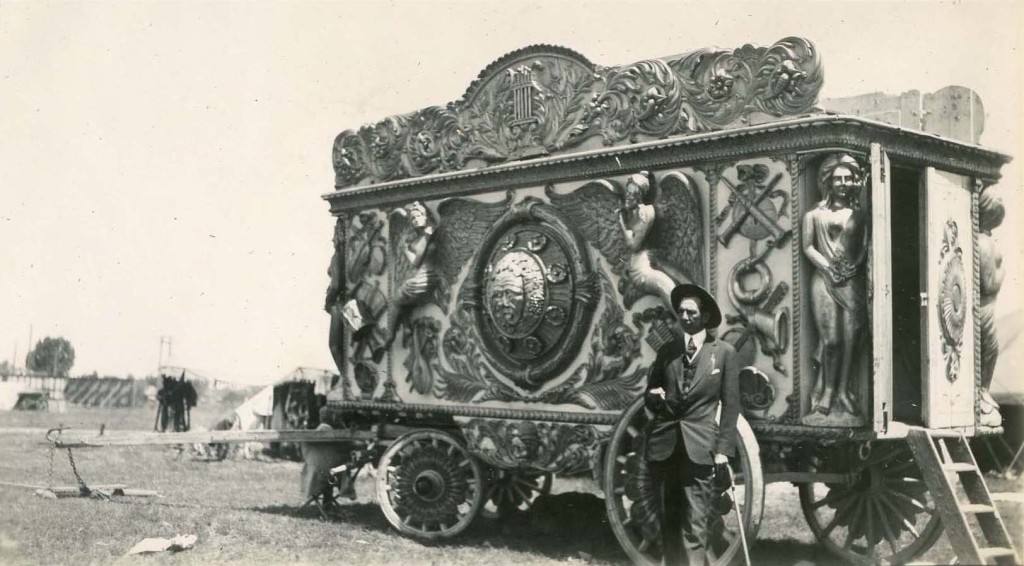 ( This undated photo shows the double doors on the back end – Joseph Bradbury Album # 18 – photo # 92B – William White Photo )
( This undated photo shows the double doors on the back end – Joseph Bradbury Album # 18 – photo # 92B – William White Photo )
After the 1925 season this wagon along with the steam calliope that had had the same history since the 1920 season vanishes from Peru. Just what happened to the wagon I am at loss to say. I am firmly convinced it didn’t go to another circus or carnival or surely we would have some knowledge of it. The best theory I have heard is that it was destroyed in a fire at Peru about 1926. One of the John Robinson barns burned at Peru about 1926, and there was a later fire the winter of 1929-30, and our best guess is that one of these two fires destroyed the wagon. It had certainly disappeared from Peru before the first of the great wagon burnings took place about 1939.
(1) Bandwagon, Vol. 1, May-June, 1957, p. 3.
If you have any questions or have more photographic evidence, feel free to contact us at circuswagons@gmail.com
